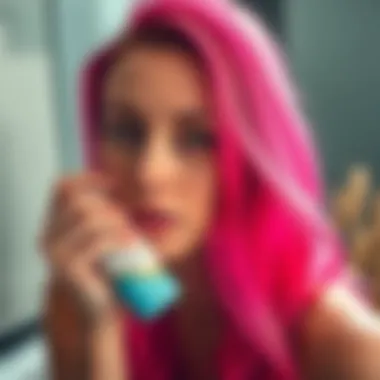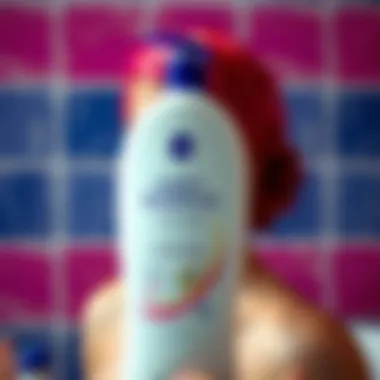Top Shampoos to Effectively Remove Hair Color


Intro
Navigating hair color changes can often feel like embarking on a roller coaster. You start with excitement, perhaps imagining how a new hue might transform your look or express your personality. But not every color sticks. Whether it’s fading too fast or simply not suiting your style anymore, you might find yourself on a quest for the right product to strip away that unwanted color.
This comprehensive guide dives deep into the best shampoos specifically designed for this task. It addresses not just the how-tos but also the why so’s. By understanding the science behind color removal, you’ll be better equipped to choose a shampoo that won’t leave your hair looking like a hot mess. We’ll discuss key ingredients that make these shampoos effective and the application methods that promise the best results. Furthermore, aftercare tips will be introduced so you can maintain hair health after the big color-stripping operation.
So grab a seat, and let’s unravel the layers of color removal with some sound advice and tested recommendations.
Foreword to Hair Color Removal
Changing hair color can be a thrilling journey, offering a fresh look that can boost confidence. However, the quest for that perfect shade may not always go as planned. Sometimes the color is too vibrant, the shade doesn’t align with expectations, or it simply becomes outdated.
In this guide, we will explore the significant aspects of hair color removal, emphasizing its relevance to those contemplating a color change. The topic not only highlights the technicalities involved in color stripping but also addresses emotional components tied to hair and identity.
Understanding Hair Color
Hair color is the direct reflection of an individual’s personal style; it can vary dramatically in hues and shades based on the dye used. The chemistry behind hair color involves pigments called melanin that are present in the hair. The different types of melanin—eumelanin and pheomelanin—combine to create varying colors, ranging from deep blacks to bright reds.
When dyeing hair, stylist often introduce artificial colors that may sit on top of the natural pigments or alter them. Over time, exposure to sun, climate, and hair care products can change how vibrant those colors look. Understanding how these factors affect color can help one better decide when and how to strip it.
Reasons for Stripping Hair Color
Stripping hair color might seem daunting, but there are many valid reasons to do it. Some of these include:
- Regret Over a Color Choice: Sometimes, a spontaneous decision leads to a shade that just doesn’t mesh well with one’s personal or professional aesthetic. Removing that color becomes necessary for a fresh start.
- Maintenance of Healthy Hair: The longer hair retains a color treatment, the more damaged it can become. Stripping hair color allows for a reset, giving the strands a chance to recover.
- Preparation for a New Color: If a new hair color is desired, beginning with a clean slate—free from previous dye—is often crucial to achieving the best result. This prevents undesired color reactions and ensures the new hue takes beautifully.
- Natural Color Reversion: Many individuals may wish to return to their natural color after a prolonged period of experimentation with artificial tones. Stripping away those colors opens up the opportunity for a more authentic self-expression.
"Hair is one of the most powerful symbols of identity—stripping color is a way to reclaim that identity anew."
Navigating the world of hair color removal requires careful consideration, knowledge, and the right techniques. By understanding why you might want to strip hair color and what it entails, individuals can make informed decisions that align with their personal hair care journeys.
Shampoos Designed to Strip Hair Color
When it comes to managing hair color, the right shampoo can make all the difference. Shampoos specifically designed to strip hair color serve not just a functional purpose but also play a crucial role in the wider narrative of hair care. They’re not merely about getting rid of unwanted dye; they also help in preserving the integrity of your hair, ensuring that transitions are as healthy as possible.
Understanding the importance of these specialized shampoos goes beyond their immediate function. They allow individuals to explore new looks and express their personality, whether it's trying out a daring shade or returning to a natural hue. This brings us to what types of color-stripping shampoos are available, and how they’re formulated to handle tough residues left by dye treatments.
Types of Color-Stripping Shampoos
Color-stripping shampoos generally fall into two specific categories: clarifying shampoos and color remover shampoos. Let's dive deeper:
Clarifying Shampoos
Clarifying shampoos are known for their potent cleaning abilities. They work wonders in removing buildup from products, minerals in water, and even hard-to-lift hair dye. Their key characteristic is that they contain a higher concentration of surfactants compared to regular shampoos. This gives them a strong edge when it comes to breaking down unwanted pigments.
Their unique feature lies in their ability to deeply cleanse without being too aggressive if used cautiously. For those who are looking to quickly refresh their locks and reduce color intensity, clarifying shampoos often become a go-to option.


However, it's important to note that overuse can lead to dryness or an imbalance in hair’s natural oils. Using them sparingly and following up with conditioner can mitigate such issues.
Color Remover Shampoos
On the other side, color remover shampoos perform a different function. They specifically target color particles themselves, breaking them down chemically rather than just washing them away. Their key attribute is that they often contain ingredients designed to oxidize dye molecules, effectively allowing for a more thorough removal.
A notable advantage of these shampoos is that they might not strip the hair of moisture as aggressively as some clarifying shampoos can. For anyone serious about maintaining hair health while removing color, color remover shampoos present a solid alternative. Yet, they can sometimes exhibit inconsistent results, depending on the dye used initially—be it a permanent, semi-permanent, or temporary color.
Key Ingredients in Color-Stripping Shampoos
Surfactants
Surfactants are the unsung heroes in the world of color-stripping shampoos. They play a pivotal role in lifting impurities and pigment particles off the hair. Their primary function is to lower the surface tension of water, enabling it to mix more effectively with oil and dirt, which is essential when trying to remove color buildup.
However, it’s critical to understand that not all surfactants are created equal. Some can be more aggressive, leading to dryness or damage, while others are milder yet still efficient. Thus, selecting the appropriate surfactant can spell the difference between maintaining vibrant hair health or facing cuticle damage post-wash.
Acids and Alkaline Agents
Acids and alkaline agents serve as both stabilizers and activators in the shampoo formula. Their key characteristic lies in their ability to shift the pH of the hair, which can affect color adherence.
Generally, a shampoo with a higher pH is more effective for stripping color as it opens up the cuticle layer, thus allowing for more thorough pigment removal. However, while they have their benefits, there’s a fine line to tread since overuse of highly alkaline products can lead to considerable hair damage or even breakage. Finding balance is essential.
Enzymes
Finally, enzymes represent a more sophisticated approach to color removal. They work by specifically targeting the dye molecules and breaking them down at a molecular level. This is particularly useful for more stubborn colors. Their benefit lies in being generally less abrasive on the hair, making enzyme-based shampoos a much more appealing choice for anyone worried about overall hair health.
Though they’re often seen as a premium ingredient, their effectiveness can vary widely depending on the formulation. That said, incorporating them into a regimen can yield great results in those tricky color correction situations.
Evaluating the Best Options
When it comes to stripping hair color, understanding how to choose from the multitude of options is essential. This section is dedicated to shedding light on the critical factors that help consumers make informed choices. Having the right shampoo can mean the difference between maintaining hair health and dealing with excessive damage, so evaluating the best options is not just about brand names or flashy packaging; it's about understanding the ingredients, effects on hair, and individual needs.
A myriad of products flood the market, each boasting unique formulas and promises. To sift through the clutter, it's crucial to consider elements like hair type, color application method, and desired outcome. A product that works wonders for one person may not yield the same results for another, thus individualized evaluation is key.
Top Picks for Shampoo to Strip Color
Product One: Features and Benefits
Product One stands out because it's formulated with natural extracts, making it a gentler option for hair color removal. One of its key characteristics is the high concentration of aloe vera, known for its soothing properties. This shampoo not only strips color but also helps keep the hair moisturized during the process.
What sets it apart is its ability to make the process less abrasive, leaving strands feeling softer to the touch. Users note that they see significant results without sacrificing hair integrity, making it a popular choice among those wary of chemical-heavy products. However, despite its gentle nature, some users may find it less effective on darker or more resistant colors.
Product Two: Features and Benefits
Product Two is renowned for its use of powerful surfactants that effectively break down color molecules. The key characteristic of this shampoo is its formulated mix of citrus extracts, providing a refreshing scent along with superior cleansing power. This product is often considered a quick solution, as users report visible effects after just one wash.


One unique feature is its ease of use, as it lathers well and is easy to distribute through the hair. However, potential drawbacks include that it may leave some hair types feeling overly stripped, requiring immediate use of follow-up conditioners. Despite this, the results speak for themselves, making it a favorite among those looking for immediate action on their color woes.
Product Three: Features and Benefits
Product Three is unique because it integrates both enzymatic and acidic agents in its formula. Not only does it aim to lift color, but it also simultaneously balances hair pH, a crucial consideration for maintaining overall hair health. This product is particularly popular for its smooth finish after color lifting, which appeals to those who prioritize both effectiveness and hair condition.
The inclusion of hydrolyzed proteins aids in restoring strength to the hair post-treatment, making it a well-rounded choice for many. While it may be on the pricier side compared to others, the investment is justified by the noticeable improvement in hair texture that often follows its use. That said, some customers have indicated that it’s less effective on synthetic colors, so it’s good to evaluate personal needs before making a purchase.
Reader Reviews and Experiences
The stories shared by users of color-stripping shampoos paint a rich tapestry of experiences. Many emphasize the importance of trial and error in finding the right product for their unique hair situations. For instance, some may rave about how Product One helped them gracefully transition through color phases, while others might suggest that Product Two delivered results too harsh for their fine hair, leading to breakage.
"Finding the right shampoo felt like hunting for a needle in a haystack. I tried a couple before settling on one that didn’t leave my hair feeling like straw!" - Reddit user
While product performance can vary significantly, shared insights can certainly guide readers in navigating their choices wisely.
Application and Best Practices
Understanding the proper application of color-stripping shampoo is essential for anyone looking to remove unwanted hair dye. It is not just about washing your hair; it’s about following specific steps that ensure effective and safe color removal without causing undue stress to your locks. Each step in the application process has its significance – from preparation to rinsing and aftercare, each detail matters greatly.
Step-By-Step Guide to Using Color-Stripping Shampoo
When it comes to using color-stripping shampoo, following a methodical approach can make all the difference. Here’s a simple guide:
- Preparation: Begin by gathering your materials. You’ll need your chosen color-stripping shampoo, a wide-tooth comb, an old towel, and perhaps some gloves to protect your hands. Ensure you’re in a well-lit area to see the results clearly.
- Wet Your Hair: Rinse your hair thoroughly until it is soaked. This helps to open up the hair cuticles, allowing the shampoo to penetrate effectively.
- Apply Shampoo: Use a generous amount of the shampoo, applying it evenly through your hair. Focus on areas with the most color build-up. It’s wise to work in sections; this helps to cover every strand more thoroughly.
- Massage Gently: With your fingers, gently massage the shampoo into your scalp and hair. Avoid being too rough, as that can lead to breakage. Think of it as a mini scalp massage.
- Set a Timer: Most color-stripping shampoos come with specific instructions, including how long to leave it in. Usually, it’s between 5 to 10 minutes. Setting a timer can ensure you don’t forget and leave it in too long.
- Rinse Thoroughly: Once the time is up, rinse out the shampoo completely. Make sure there's no residue left, as it can affect the next step in your hair routine.
- Condition: After rinsing, always follow up with a deep conditioner. Stripping color can leave hair feeling a bit dry, so moisture is key for recovery.
Using this guide allows for a smoother experience when removing hair color. It gives you control over the process, ensures you get the best results, and minimizes damage.
Frequency of Use
Knowing how often you should use color-stripping shampoo is crucial for maintaining hair health. The frequency largely depends on the hair type, thickness, and the intensity of colors previously applied. Here are some guidelines:
- Light Shades: If your hair is naturally light and you often apply pastel colors, using the shampoo once every four to six weeks might be sufficient to keep things fresh without overdoing it.
- Dark Colors: Those with darker shades or multiple dye layers should limit applications to once every two months. Frequent use can lead to significant dryness or brittleness, particularly in darker, thicker textures.
- Operational Method: It can also be beneficial to alternate with a gentle clarifying shampoo. This can help cleanse the scalp and roots while providing a break for your hair.
Ultimately, every head of hair is unique. Keeping a close eye on how your strands respond can guide your decisions on frequency. Avoiding overuse will keep your hair feeling healthy and vibrant, ensuring it remains in the best condition after each color transition.
Remember, it's not just about stripping color; it's also about keeping your hair happy!
To further deepen your understanding of hair care practices and color treatment, you may consult resources from Mayo Clinic, WebMD, or educational materials from Harvard Health.
Aftercare Following Color Removal
After stripping hair color, it is vital to prioritize aftercare. The process used in removing hair color can leave your strands feeling a bit like dried hay—brittle and lacking vitality. Aftercare isn’t just a nice-to-have; it’s a necessary step to ensure that your hair bounces back stronger than ever. Let’s dive into restorative treatments and hydration strategies that will keep your hair in tip-top shape.
Restorative Treatments for Hair Health


Once the color is gone, your hair might be crying out for help. The harsh chemicals in stripping shampoos can often lead to damage, and the first order of business is to give your tresses some much-needed TLC. A few top-notch restorative treatments include:
- Deep Conditioning Masks: Look for masks loaded with natural oils and proteins. Ingredients like argan oil or keratin can work wonders in bringing your hair back to life.
- Leave-In Conditioners: A leave-in product can keep your hair nourished throughout the day. These products provide necessary moisture and form a protective barrier against environmental stressors.
- Hair Oils: Applying a nourishing hair oil can significantly improve the texture of your hair while also offering shine. Products containing jojoba or coconut oil are fantastic choices.
Using these treatments at least once a week can make a world of difference in restoring health to your hair. Remember, consistency is key.
Hydration and Moisture Management
Keeping your hair hydrated goes hand in hand with restorative treatments. Stripping shampoos can wick away moisture, leaving hair dry and lifeless. To combat this:
- Hydrating Shampoos: Opt for sulfate-free options that focus on moisturizing while still cleansing your hair. Shampoos infused with ingredients like aloe vera or shea butter help retain moisture.
- Adjust Water Temperature: While it feels good to wash hair with hot water, it may contribute to further dryness. Go for lukewarm or cool water to help maintain the hair's natural moisture.
- Drink Plenty of Water: Don’t forget that hydration starts from within. Keep yourself hydrated to see results not just in how your hair feels, but also in its overall appearance.
"Healthy hair leads to healthy confidence. Treat it right!"
Incorporating these practices into your post-color removal routine can ensure that your hair not only survives the stripping process but thrives afterward. By focusing on hydration and restorative treatments, you can transform your hair from feeling fragile back to embodying strength and shine.
Potential Risks and Considerations
When it comes to stripping hair color, it’s crucial to grasp the potential risks involved. Many women who try to change their look often overlook these aspects, leading to disappointment and even damage. Understanding the side effects and how to choose the right product can save your hair from unnecessary trauma.
Stripping hair color is not just a straightforward wash and go. It usually involves strong ingredients that can compromise your hair’s integrity if not handled carefully. Here’s where it gets a bit sticky: the effectiveness of stripping shampoos varies, and not all products suit every hair type.
Side Effects of Stripping Shampoos
Using a shampoo that strips color can be a double-edged sword. While it can help purge unwanted tones, it often brings its own batch of side effects. Common fallout includes:
- Dryness: Your hair might feel like straw after using these shampoos. This is especially true for those with already dry or damaged hair.
- Breakage: Stripping shampoos can weaken the hair shaft, making it prone to breakage.
- Scalp Irritation: Some formulations may lead to a flaky or itchy scalp, especially if you have sensitive skin.
If you notice excessive shedding after using such products, you might want to reconsider your approach. A patch test can be beneficial before going all in with a new product.
"Rushing to strip hair color can leave you with hair that feels more like hay than silk. Always proceed with caution."
Choosing the Right Product for Your Hair Type
Not every shampoo is created equal. It’s vital to choose products that align with your hair’s specific characteristics. Factors you should consider include:
- Hair Texture: If you have fine hair, opt for lighter formulas that won’t weigh it down. In contrast, thicker or coarser textures may tolerate more potent ingredients.
- Color Level: The depth of your current color influences which stripping shampoo will work best. For dark hair, you might need a stronger product compared to someone needing to remove pastel shades.
- Chemical Treatments: If you’ve had previous color treatments or chemical processes, look for gentle options with moisturizing agents.
A savvy approach involves reading labels, checking online reviews, and maybe even seeking advice from a stylist who understands your hair journey. It’s not just about getting rid of color; it’s about doing so while keeping your hair healthy and manageable.
Opting the right shampoo is akin to pairing the right wine with a meal. Get it wrong, and you might spoil the experience. Choose wisely!
Epilogue and Final Thoughts
In closing, the journey of stripping hair color can be both transformative and daunting. Selecting the right shampoo is pivotal, not just for achieving the desired shade, but also in safeguarding hair health. This article has delved into the essentials, outlining what makes a good shampoo for color removal and the importance of understanding each product's ingredients.
The key takeaways serve as a guidepost, helping women navigate the often confusing world of haircare. Remember, fewer things are more impactful than making an informed choice about hair products. With the right tools in your hands, achieving healthy and beautiful hair post-color removal is within grasp.
"Choosing wisely is like finding a pearl in the ocean; it requires patience but yields natural beauty."
Every woman’s hair is a storytelling canvas. Thus, when determining which shampoo to use, take the time to consider factors such as hair texture, previous treatments, and even personal hair goals. Always opt for reputable brands and read up on user experiences.
Mitigating risks, understanding potential side effects, and prioritizing restorative treatments post-stripping not only maintain hair quality but also enhance overall confidence. As you embark on this hair journey, consider the broader picture—hair is not just about color; it's about expression and identity. Embrace your choices, and let your hair shine!







